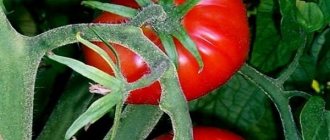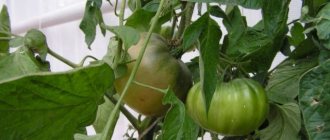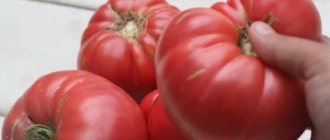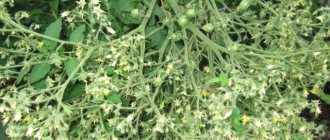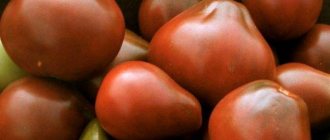The Tea Rose tomato combines beauty and great taste. A plant in a garden bed, hung with large trusses of tomatoes, attracts attention, and one large fruit is enough for a salad for the whole family.
| Height | Landing location | Ripening time | Fruit color | Fruit size | Origin | Fruit shape |
| Tall | Greenhouse | Early ripening | Pink | Large | Variety | Round |
Description of the variety
The Tea Rose is characterized by an impressive bush height (up to 2 m), high disease resistance and high yield. The period of full ripening from 90 to 100 days characterizes the variety as early ripening. The weight of the spherical fruit can reach 0.4 kg.
The average yield per plant reaches 6 kg of fruits, which tolerate transportation and long-term storage well. Fruiting is consistent throughout the entire period of growth and ripening. The decorative appearance of the plant is given by weighty clusters of many (5-7 pieces) fruits on one bush.
Fruit characteristics
Tomatoes have universal qualities, suitable for direct consumption, for preparing salads, snacks, sauces and canning for the winter. The benefits of fruits are due to the high content of vitamins, microelements and beneficial amino acids. The taste and aroma qualities of the variety are beyond praise. The pulp contains a minimum of water and seeds, is fleshy, resistant to cracking, and dense.
High intensive growth of bushes necessitates tying and installing support posts. This should be considered one of the disadvantages of the variety.
Variety with large pink fruits - tomato Tea rose F1: description of tomatoes and characteristics
The Tea Rose tomato combines beauty and great taste. A plant in a garden bed, hung with large trusses of tomatoes, attracts attention, and one large fruit is enough for a salad for the whole family.
| Height | Landing location | Ripening time | Fruit color | Fruit size | Origin | Fruit shape |
| Tall | Greenhouse | Early ripening | Pink | Large | Variety | Round |
Description and characteristics of the variety
Tomato Tea Rose from “Siberian Garden” is tall, indeterminate type, up to 1.8-2 m. The bush is covered with small dark green leaves in medium quantities. Tomatoes grow on clusters of 4-6 pieces. They ripen 95-100 days after the sprouts hatch.
The fruits are large, on average 200-300 g, but you can get tomatoes up to 600-800 g using special techniques. Their color is deep pink, with a pearly tint visible on the skin. The tomatoes are round, with a slight ridge at the top.
The pulp is medium density, juicy, sugary, with excellent taste. The dry matter content is average. Tomatoes can be used for any culinary recipes and for fresh consumption, but they cannot be preserved in jars due to their large size.
Advantages and disadvantages
- great taste;
- attractive appearance;
- high productivity;
- a large number of vitamins, amino acids and other useful substances;
- resistance to cold conditions;
- good immunity to diseases.
Minuses:
Productivity
From 1 bush you get up to 6 kg of tomatoes.
Features of cultivation and storage
Although the variety is able to withstand temperatures slightly below normal and changes, the yield will be better in a greenhouse. Shelter is necessary in the middle zone and to the north. In the south, cultivation in open ground is allowed.
It needs to be formed, preferably 2 stems, and pinched when the top reaches the roof of the greenhouse or a month before the end of fruit ripening. The stems are tied to supports or trellises.
Planting and care
Sowing of seeds is carried out two months before transferring the bushes to the garden bed. They and the soil are disinfected with a solution of potassium permanganate and germinated at +21-24 degrees.
When sprouts appear, it is necessary to maintain constant bright lighting for 14 hours a day. Picking in the phase of two true leaves.
Water the roots with settled water and be sure to feed them.
Diseases and pests
The variety has good resistance to major diseases. To reduce the risk of disease, it is necessary to maintain an average level of soil moisture and conduct regular ventilation in the greenhouse. The temperature in the shelter should not exceed +25. Also, you should not thicken the plantings and place tomatoes next to potatoes, peppers, and eggplants, otherwise species diseases will be transmitted between them.
Spraying with a solution of copper sulfate or other products containing copper will protect against late blight. Sick bushes are immediately destroyed, and the rest are processed again.
To prevent pests from coveting the tomato, plant fragrant plants nearby - basil, tobacco, celery, parsley, marigolds or mint. For mole crickets and naked slugs, spray the beds with diluted ammonia, for spider mites and aphids - with celandine infusion or soap solution. Only an insecticide or manual control will help against Colorado potato beetles.
How to grow seedlings
It is better to start growing Tea Rose tomatoes in seedlings in the second half of March. Seed material must be carefully prepared in a standard way, by soaking or treating with a growth stimulant.
Suitable preparations are available in garden stores. This will help increase further germination and productivity of plants.
Container and soil
The basic requirements for soil are looseness and nutritional value. Tea rose loves to be fed with fertilizers. Soddy soil with a high content of peat and humus is quite suitable for sowing.
Standard containers are suitable for seedlings; drainage can be placed at the bottom.
Sowing
The seeds are placed in depressions in the soil and sprinkled with loose peat.
After sowing, it is necessary to moisten the soil (it is possible to use liquid fertilizers) and cover it with plastic film. This will create a favorable microclimate and help timely plant growth.
The development of seedlings requires constant adherence to the temperature regime, in the range of 21-27⁰С.
Growing and care
The culture tolerates moisture and light well. The average time for shoot germination varies from a week to 10 days. This period is enough for the sprouts to get stronger, and it is possible to remove the film and take the containers out into the light. These are necessary conditions for proper acclimatization and hardening of plants before transplanting into the ground.
During this period, seedlings should be watered moderately, but the soil should not be allowed to dry out. The variety is quite moisture-loving. Good natural lighting is necessary. After the first shoots appear, they need to be allowed to grow stronger and produce at least a couple of leaves. This is the time to dive.
Planting plants requires preparatory steps, which include feeding the plant. Liquid complex fertilizer for nightshades is best suited. This must be done at least twice, immediately before transplantation. The interval between feedings is at least 7 days. It is also a good idea to take preventive pest control measures. You can treat the soil with a solution of Fitosporin.
The soil intended for planting seedlings must be well fertilized and loosened . Manure is suitable, and local laying of eggshells will help accelerate the development of the tomato root system. It should not be added to the entire soil, but only to the places where seedlings are planted.
You can plant plants in the ground using a checkerboard pattern. One plant is at the usual depth, the next one is immersed in the ground to the level of the first pair of leaves. This will create convenience for subsequent care of the bushes and increase the resistance of the upper layers of soil from drying out.
A suitable irrigation method is drip. The intensity depends on the amount of precipitation and periods of drought. During the flowering period, increased watering is necessary. It is not advisable to allow the soil to dry out, but excess moisture also leads to the risk of disease of the root system. You need to stick to the golden mean.
Once a week you can feed the plant with liquid mineral fertilizers or organic matter.
How to grow tomatoes
Planting plants in open ground must comply with a number of conditions. This applies to soil, temperature, lighting, and so on.
If the seedling method is intended, then it is necessary to first prepare the seedlings by hardening and acclimatization. The appropriate time depends on the climate in the region and the conditions where the tomatoes will grow. If it is a greenhouse, you can start at the end of May. If it is open ground, it is better to wait until mid-June.
It is recommended to place no more than three plants on one square meter of soil. This will make it easier to access the bushes during subsequent care (watering, fertilizing, tying up bushes).
TOMATOES - FROM SOWING TO HARVESTING IN ONE VIDEO! How to grow great tomatoes?
Care
The variety is characterized by increased consumption of moisture and nutrients. The soil needs to be frequently fertilized with mineral fertilizer complexes. Water for irrigation should not be colder than 15⁰. Watering should be done every 7-12 days. At least 5 liters of water per bush. In dry, hot weather, the volume increases to 10 liters. It is recommended to loosen the soil between waterings. This will provide additional opportunities for air access and prevent possible rotting of the bush.
Optimal air humidity should be in the range of 65 – 70%, air temperature 23-25 ⁰С.
Features of cultivation and possible difficulties
Plant growth in greenhouse conditions can reach 2 m, in open ground up to 1.5 m. It is necessary to give the plant additional vertical support for one or two stems (posts, pegs). It is also useful to remove side shoots that interfere with the growth of the bush - pinching.
We choose the time for sowing seeds for seedlings with a reserve. About 65-70 days should pass before planting in the ground.
Diseases and pests
A big plus of this variety is its high resistance to common diseases and pests . Following crop cultivation techniques reduces the risk of disease to a minimum. Most often, Tea rose is affected by a viral infection. Preventive inspections, mulching, the use of special compounds (Fitosporin) and weeding of the soil will protect plants from diseases.
The main insect pests that attack the Tea Rose are: Colorado potato beetle, thrips, whitefly and spider mite. Methods of combating these pests are typical and well known to all amateur gardeners. A good preventative measure would be to plant herbs next to tomatoes. The smell of mint or parsley irritates insects.
Diseases and pests
When breeding this variety, breeders paid special attention to ensuring that the plant could resist diseases and pests.
Gardeners should periodically inspect the bushes for the first signs of a viral infection, which often affects the Tea Rose. On the other hand, with proper care, you will not have to worry about the development of other serious diseases. Using mulch or careful weeding in combination with preventive measures will protect the bushes from insect attacks.
The nuances of growing in open ground and in a greenhouse
The “Tea Rose” tomato variety was bred by domestic breeders in 2021 mainly for planting in greenhouses and greenhouses. The stable warm climate of southern Russia allows gardeners to grow this variety in open ground.
Differences when planting in a greenhouse and open ground are due to external factors, such as the climate in the region. If tomatoes can be planted in a greenhouse already in mid-May, then in open ground no earlier than the first half of June.
In greenhouse conditions, the plant reaches its maximum development. The height reaches 2 m, the yield is 6 kg per bush. In open ground these figures drop to 1.5 m and 4.5 - 5 kg.
Greenhouse conditions create their own microclimate, in which it is easier to control and maintain the necessary conditions: air temperature, light and humidity. In open ground, the likelihood of the plant freezing at night increases; the crop is exposed to cold air currents.
The Tea Rose tomato variety loves good lighting. In winter, it is necessary to increase daylight hours artificially. It’s easier to do this in a greenhouse, turning off artificial lighting for 6 – 8 hours a day.
Watering in open ground should be done with warm water, 16 - 18⁰С. In a greenhouse, it is permissible to use water no colder than 15⁰C.
Both in open and in closed ground, the crop is fertilized throughout the entire ripening period.
Agrotechnics of cultivation
The ability to grow the crop in open and closed ground conditions expands the geography of distribution of the variety. The southern regions are suitable for open ground.
The central and northern regions are suitable for cultivating tomatoes in greenhouse conditions. At the initial stage of bush formation, the plant requires abundant watering, fertilizing with complex fertilizers and selection of lighting conditions.
Sowing seeds for seedlings is carried out in March. At the stage of formation of 1-2 true leaves, picking is carried out in order to strengthen the plant. Growing planting material requires periodic drip irrigation of the soil. The formed seedlings need to be planted in a permanent place in mid-May.
Despite the variety's resistance to diseases of nightshade crops, May Rose can be affected by brown rot. As a method of combating the disease, mechanical removal of infected leaves is carried out.
After this, the amount of nitrogen fertilizers and watering are reduced, and the plant is treated with drugs. For preventive purposes, regulate the lighting and irrigation regime.
May rose bushes love watering. Preparations containing potassium and calcium are recommended as fertilizers, which can ensure good growth and protection.
Harvesting and application
If the cultivation technology is followed, the “Tea Rose” tomato variety will delight gardeners with an abundant harvest of fruits with an ideal round shape. The size of tomatoes on one bush may vary. This is a plus of the variety. Large ones will be used for salads, appetizers, and sliced food. Medium ones are ideal for canning for the winter.
The taste qualities of the variety do not leave the most fastidious gourmets indifferent. The fruits are well stored, do not lose their taste, are quite resistant to cracking and tolerate transportation well. There is no practical sense in collecting unripe fruits with the prospect of ripening.
Advantages and disadvantages
The main disadvantage when growing the Tea Rose variety is the need to provide the plant with additional support (tying, driving in vertical pegs) and pinching. The plant also requires regular feeding with mineral fertilizers throughout the entire ripening cycle.
The main advantages of the Tea Rose variety:
- Excellent taste of the fruit.
- High yield.
- The fruits are well transported and resistant to damage.
- A beautiful decorative view of a plant in a garden bed.
- Tomatoes are rich in vitamins and amino acids.
- Cold resistance of the variety.
- The fruits are suitable for eating raw, cooking, and canning.
Farmer reviews
Here are reviews from gardeners who have grown the “Tea Rose” tomato variety in practice.
Marina, Rostov-on-Don : “Thank you to the breeders for this hybrid. I grew it in the country last year. I was very pleased. I will definitely continue to plant Tea Rose tomatoes.
Ignat, Volgograd: “I planted the Tea Rose tomato variety in 2021. I was happy about the good harvest and the absence of diseases. Thanks to Russian agronomists!”
Liana, Smolensk: “I grew the variety in my greenhouse. I had to tinker a little when tying up the bushes and loosening the beds. But the good harvest more than paid for all the efforts.”
Tomato Tea Rose
author of the photo Homemade tomato from Angelina
Description of the tomato variety Tea Rose, reviews, photos
Mid-season, indeterminate (unlimited growth), productive tomato variety. In the middle zone, it is recommended to grow it in a greenhouse.
The bush is up to 1.8 meters high; it requires tying to a support and pinching. The best results were obtained when forming a plant with 2 stems.
Fruit characteristics
The fruits are round, ribbed towards the stalk, pink in color with mother-of-pearl at maturity, weighing 200-300 grams (up to 400 g), fleshy, excellent taste. These tomatoes are good for fresh consumption, as well as for making juices and sauces.
Features of cultivation
Sowing the seeds of this variety of tomatoes for seedlings is carried out 60-65 days before the intended planting in the ground. Seedlings dive at the stage of two true leaves. When planting seedlings in a permanent place per 1 sq. Up to 4 plants are placed per meter of the prepared area.
Tea rose tomatoes, video
If you grew Tea Rose tomatoes, please write whether you liked them or not. What was the yield and taste of the fruit? Will you grow them again? How do you rate the disease resistance of this variety? Briefly describe the advantages and disadvantages of this tomato in your opinion. If possible, attach a photo of the entire bush or individual fruits you grew to your comment. Thank you!
Your reviews of the Tea Rose tomato and additions to the description will help many gardeners evaluate this variety objectively and decide whether it is worth planting or not.



